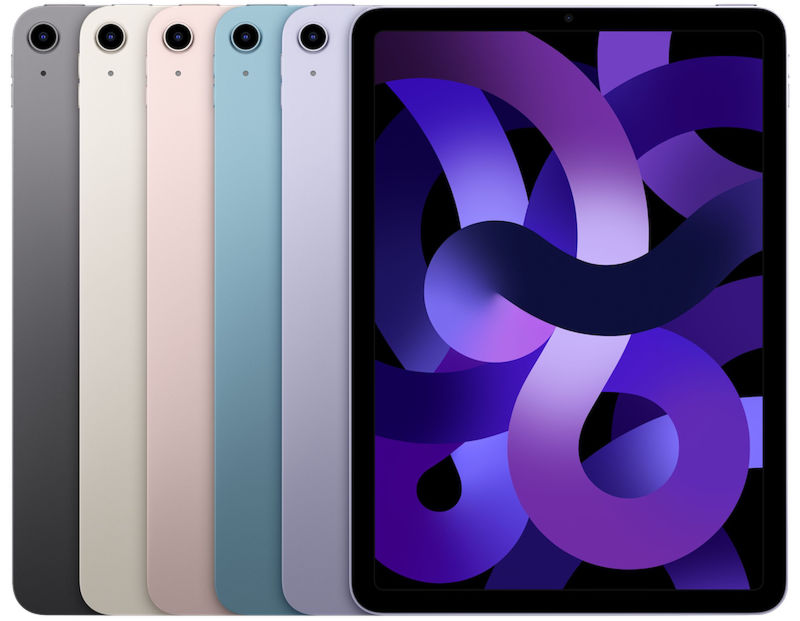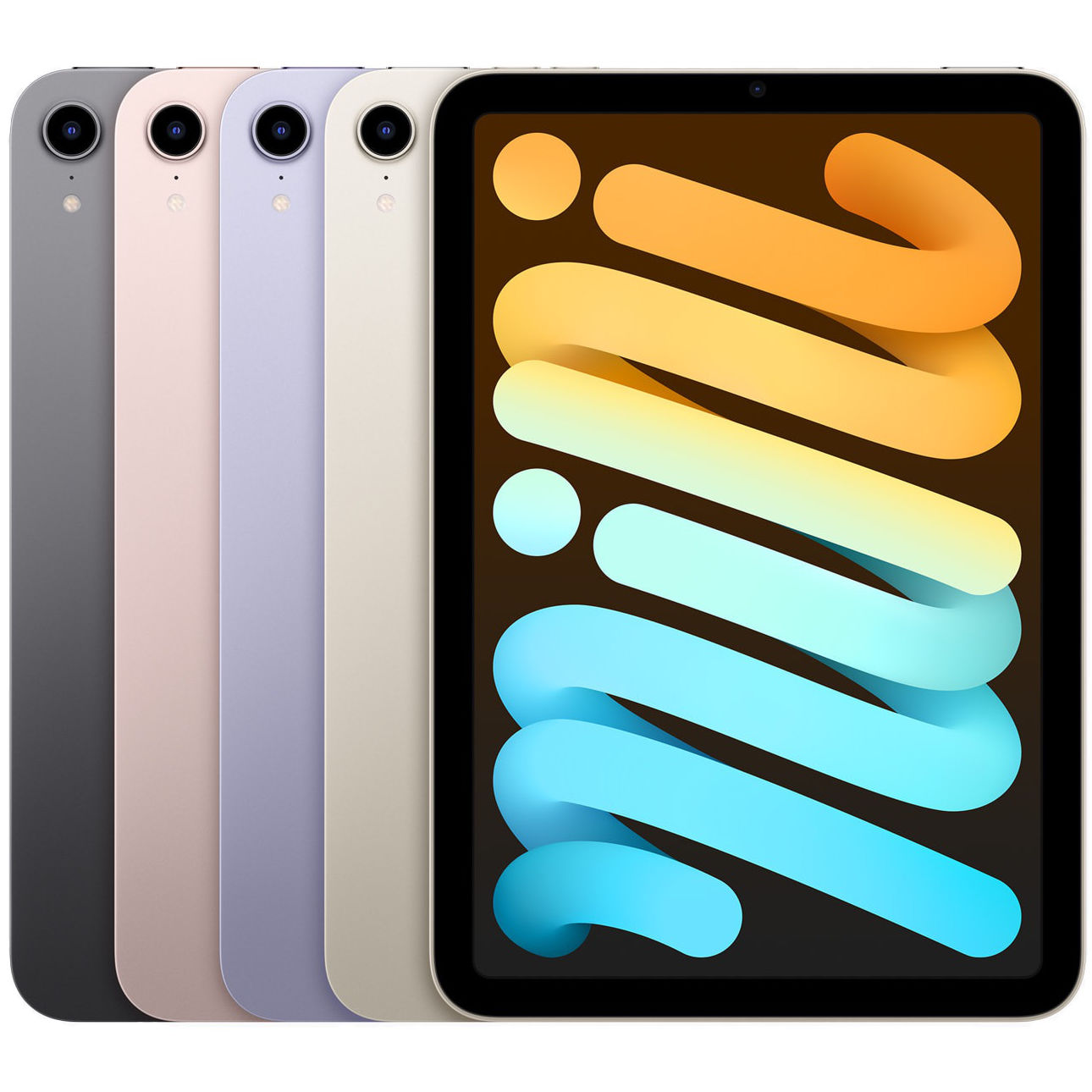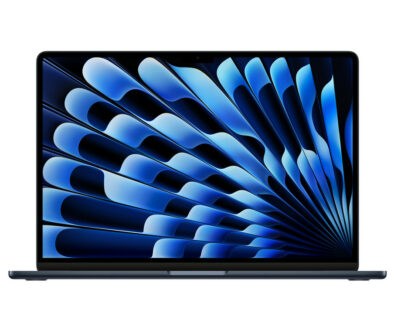iPad Air 4th Gen (2020) vs iPad Air 5th Gen (2022): Apple M1 chip & more
Next to the entry level iPad 10.2-inch, the iPad Air 10.9 is a firm favourite among those in Education and Apple has made it even more appealing. The fifth generation iPad Air may look the same bar colour options, but it is now powered by the Apple M1 chip making it the most affordable tablet spotting Pro level performance.
What has improved
Here is a quick overview:
- The M1 chip with next generation Neural Engine
- Ultra Wide 12MP front camera and with that…
- Centre Stage and 2x zoom out on the front camera
- Dynamic range video recording support on the front and rear cameras for up to 30fps
- 5G connectivity for super fast download and high quality streaming
1. The Apple M1 chip
The single biggest improvement is the processor. The tablet moved from using a mobile focused efficient chip, the Apple A14 Bionic chip that it shared with the iPhone 12 to a more powerful Apple M1 chip. Apple’s first silicon, the Apple M1 chip appeared everywhere except on the iPhone and entry level iPad and iPad mini. It powers the desktops and laptops like the Mac mini, iMac 24 (2021), MacBook Air M1 and MacBook Pro 13 M1.
On the tablet side, it was first introduced in the iPad Pro 5th Gen launched back in 2021. No doubt, when the Pro tablet is due for a refresh, it will receive the M2 chip first introduced in the all new MacBook Air M2 (2022) and MacBook Pro 13 M2 (2022). But, for now, the mid-range iPad Air 5th gen gets to share the same level of performance as its Pro cousin.
The Silicon-on-Chip comes with 8-core CPU (4 performance cores and 4 efficient cores) and next generation Neural Engine. Apple claims that this give site iPad Air 60% more processing powered compared to its predecessor powered by A14 Bionic. It is easy to see where all that come from. There is the 8-core CPU which is two more than the number of CPU cores on the A14 Bionic.
For graphics, the M1 has 8-core GPU, double that on the A14. It also comes with 8GB unified memory which again is way more than the iPad Air 2020, double again from 4GB. That is indeed a huge jump and it totally narrows the performance gap between the mid-range iPad Air and the iPad Pro. For the money, it is definitely better value especially when compared to the iPad Pro 11 M1.
Here are some performance benchmarks comparing the two chips over at cpu-monkey.

2. Ultra Wide 12MP Front Camera
The new iPad Air 5th Gen (2022) shares the same front facing camera sensor with iPad Pro M1 albeit without TrueDepth support. The 12MP Ultra Wide front camera is a huge upgrade from the 7MP FaceTime HD camera in the previous iPad Air. We have seen the same sensor in use in the iPad 10.2 (2021) with great result. Here is a comparison table between the front camera on the iPad 10.2 (2021), iPad Air 5th Gen (2022) and iPad Pro 12.9 (2021).
iPad Air (2022) vs iPad 10.2 (2021) vs iPad Pro (2021) Front Facing Camera Features
| iPad 10.2 (2021) | iPad Air 10.9 (2022) | iPad Pro (2021) |
| FaceTime HD Camera | FaceTime HD Camera | TrueDepth Camera |
| 12MP Ultra Wide camera, 122° field of view | 12MP Ultra Wide front camera, 122° field of view | 12MP Ultra Wide camera, 122° field of view |
| ƒ/2.4 aperture | ƒ/2.4 aperture | ƒ/2.4 aperture |
| NA | NA | Portrait mode with advanced bokeh and Depth Control |
| NA | NA | Portrait Lighting with six effects (Natural, Studio, Contour, Stage, Stage Mono, High‑Key Light Mono) |
| NA | NA | Animoji and Memoji |
| HDR for photos | Smart HDR 3 | Smart HDR 3 |
| 1080p HD video recording at 25 fps, 30 fps, or 60 fps | 1080p HD video recording at 25 fps, 30 fps, or 60 fps | 1080p HD video recording at 25 fps, 30 fps or 60 fps |
| Time‑lapse video with stabilization | Time‑lapse video with stabilization | Time-lapse video with stabilisation |
| Extended dynamic range for video up to 30 fps | Extended dynamic range for video up to 30 fps | Extended dynamic range for video up to 30 fps |
| Cinematic video stabilization (1080p and 720p) | Cinematic video stabilization (1080p and 720p) | Cinematic video stabilisation (1080p and 720p) |
| NA | Wide color capture for photos and Live Photos | Wide colour capture for photos and Live Photos |
| Lens correction | Lens correction | Lens correction |
| Retina Flash | Retina Flash | Retina Flash |
| Auto image stabilization | Auto image stabilization | Auto image stabilisation |
| Burst mode | Burst mode | Burst mode |
As you can see, the front facing camera on the iPad Air 10.9 (2022) is not far off from that found on the entry level iPad 10.2 (2021). The only differences are Smart HDR 3 support and wide colour capture for photos and Live Photos. Essentially, these are the same optics with different software optimisations. The same can be said with the front facing camera on the iPad Pro. Given the aperture size, you can easily conclude that these are in fact the same camera.

Front Facing Cameras: iPad Air 10.9 5th Gen (2022) vs iPad Air 10.9 4th Gen (2020)
For the purpose of this article, we compare the camera on the new with the previous generation iPad Air. Here is a table comparing the two front facing cameras side-by-side.
| iPad Air 10.9 4th Gen (2020) | iPad Air 10.9 5th Gen (2022) |
| FaceTime HD Camera | FaceTime HD Camera |
| 7MP photos | 12MP Ultra Wide front camera, 122° field of view |
| ƒ/2.2 aperture | ƒ/2.4 aperture |
| Smart HDR | Smart HDR 3 |
| 1080p HD video recording at 60 fps | 1080p HD video recording at 25 fps, 30 fps, or 60 fps |
| NA | Time‑lapse video with stabilization |
| NA | Extended dynamic range for video up to 30 fps |
| NA | Cinematic video stabilization (1080p and 720p) |
| Wide color capture for photos and Live Photos | Wide color capture for photos and Live Photos |
| NA | Lens correction |
| Retina Flash | Retina Flash |
| Auto image stabilization | Auto image stabilization |
| Burst mode | Burst mode |
| Exposure control | |
| Timer mode | |
| Backside illumination sensor |
As to be expected, there is a huge upgrade to the front facing camera found on the new iPad Air 5th Gen. Apart from the 12MP ultra wide camera sensor, it supports Smart HDR 3, stabilisation for time-lapse video, extended dynamic range for video up to 30fps and cinematic video stabilisation. Given its wide angle lens, it also benefit from automatic lens correction. The biggest upgrades in our book are the extended dynamic range support and cinematic video stabilisation. This means, you can use the front facing camera to capture tutorial videos, talking heads and demonstration as well as high definition video calls up to 1080p with amazing details, dynamic colour and contrast.

3. Centre Stage and 2x Zoom Out
With the 12MP Ultra Wide front camera comes two distinct features, first on the iPad Air, the support for Centre Stage during call or video recording and 2x Zoom out. The latter is digital as it involves cropping into an already wide angle image or video. The thing is, even the entry level iPad 10.2 now supports Centre Stage so it is about time, the feature finds its way into a mid-range device.
4. Dynamic Range Video Recording Support
Enough of the front facing camera, let’s look at the main camera. The rear single 12MP wide camera on the new iPad Air 2022 now supports up to 5x digital zoom. Other features remained pretty much the same except for dynamic range video recording. Just like the front camera, the rear camera now supports recording in dynamic range.
Rear Facing Main Camera
| iPad Air 10.9 (2020) | iPad Air 10.9 (2022) |
| Main Camera | Main Camera |
| 12MP Wide camera, ƒ/1.8 aperture | 12MP Wide camera, ƒ/1.8 aperture |
| Digital zoom up to 5x | |
| Five-element lens | Five-element lens |
| Hybrid IR filter | |
| Panorama (up to 63MP) | Panorama (up to 63MP) |
| Smart HDR 3 for photos | Smart HDR 3 |
| Live Photos with stabilization | |
| Autofocus with Focus Pixels | Autofocus with Focus Pixels |
| Tap to focus with Focus Pixels | |
| Wide color capture for photos and Live Photos | Wide color capture for photos and Live Photos |
| Exposure control | |
| Noise reduction | |
| Auto image stabilization | Auto image stabilization |
| Burst mode | Burst mode |
| Timer mode | |
| Photo geotagging | Photo geotagging |
| Backside illumination sensor | |
| Image formats captured: HEIF and JPEG | Image formats captured: HEIF and JPEG |
Video Capture Features
| iPad Air 10.9 (2020) | iPad Air 10.9 (2022) |
| Video Capture | Video Capture |
| 4K video recording at 24 fps, 30 fps, or 60 fps | 4K video recording at 24 fps, 25 fps, 30 fps, or 60 fps |
| 1080p HD video recording at 30 fps or 60 fps | 1080p HD video recording at 25 fps, 30 fps, or 60 fps |
| 720p HD video recording at 30 fps | |
| Slo‑mo video support for 1080p at 120 fps or 240 fps | Slo‑mo video support for 1080p at 120 fps or 240 fps |
| Time‑lapse video with stabilization | Time‑lapse video with stabilization |
| NA | Extended dynamic range for video up to 30 fps |
| Cinematic video stabilization (1080p and 720p) | Cinematic video stabilization (4K, 1080p, and 720p) |
| Continuous autofocus video | Continuous autofocus video |
| Playback zoom | Playback zoom |
| Video formats captured: HEVC and H.264 | Video formats captured: HEVC and H.264 |
| Video geotagging | |
| Noise reduction |
5. Ultra fast 5G cellular connectivity
With the M1 chip also comes 5G cellular connectivity for super fast streaming and browsing. Get a contract, stick a nano-SIM or use eSIM to connect to 5G broadband and bob is your uncle. Here is an iPad that is future proof, ready for super fast downloads and high definition streaming.
Other than the five key features highlighted above, you also get new colour options. There is now Space Gray, Starlight, Pink, Purple and Blue. Previously, iPad Air 4 2020 comes in Silver, Sky Blue, Rose Gold, Space Gray or Green.
Except for the Blue option, the iPad Air 5th Gen’s colour options mirror that of the iPad mini 6th Gen 2021 shown below.

What stayed the same
- Design wise, apart from the colour, they are identical dimension wise with its drop edge and rounded corner design
- The same 10.9-inch Liquid Retina display Still no ProMotion technology so no high display refresh rate
- Storage options starts from 64GB with the only other option available at 256GB
- Both device still work with Apple Pencil 2nd Gen and Magic Keyboard or Smart Keyboard Folio
- USB-C connector for charging and to connect external peripherals like storage, camera, microphone or music keyboard.
- They use the same display panel, Liquid Retina display with the exact same specifications
- Battery life also stays the same, up to 10 hours of browsing via WiFi or watching video. If you have a cellular model, up to 9 hours of surfing on cellular broadband.
- For audio, these again share the same stereo speaker setup in landscape mode
- Then there is Touch ID. The favourite fingerprint sensor built into the top power button stays.
- Finally, wireless connectivity beyond cellular; the WiFi 6 and Bluetooth 5.0 are shared between them. Same goes for sensors; Touch ID, three-axis gyro, accelerometer, ambient light sensor and barometer.
Would you upgrade?
If you are looking for a new mid-range tablet, the iPad Air 5th Gen 2022 with Apple M1 chip is an amazing buy especially with its powerful chip, Centre Stage enabled front camera and 5G connectivity option. But, if you already have the previous iPad Air 4th Gen 2020 with Apple A14 Bionic, it is best to stick with it for now. At the time of writing, Apple still supports iPadOS on 2nd, 3rd and 4th Gen iPad Air, so you would not be left out hanging when it comes to software support, not for the foreseeable future. Given the lifespan of devices these says, it will probably still be supported in 2025/26. However, if you must have Centre Stage or 5G then the iPad Air 5th Gen is as good as the iPad Pro 11-inch M1 2021, certainly better value.


















